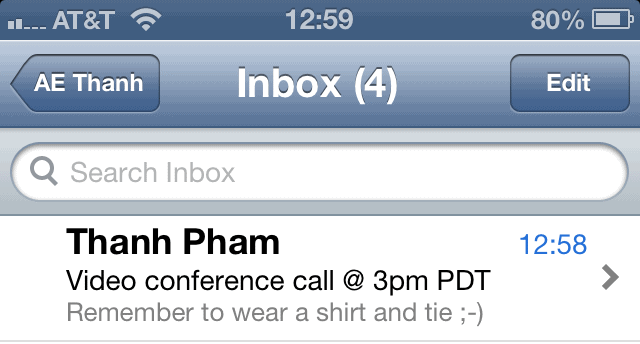
One of the quick wins for everyone who wants to spend less time managing emails is by writing effective subject lines. When you and everyone else around you writes productive email subject lines, you all save time.
Here are our top 5 tips for writing productive subject lines that will save you and your team time.
1. Avoid One-Word Subject Lines
This is one of the most common problems – people use one-word subject lines such as “opportunity”, “video” or “report”. Or even worse, blank subject lines (those people should be sent to a deserted island).
When the recipient receives your email, that person should know right away what the email is about by just reading your subject line. This means avoiding one-word subject lines and becoming more verbose with them.
Don’t be afraid to use multiple words – or even better – good keywords. It’s common for people to search for emails so make it easy for them to find your email by crafting a keyword rich email.
Bad: Dinner
Good: Dinner party at Stacy
Bad: Report
Good: TPS Report for Q2
2. Be Specific
On top of avoiding one-word subject lines, try to be as specific as possible. The more specific you are with your subject line, the less you have to write in the body of the email. Plus it’s easier for the recipient to scan, search and reference your email when you write specific subject lines.
Here’s an example.
Bad: Dinner
Good: Dinner party at Stacy
Best: Dinner party at Stacy this Sat (Nov/7) @ 8pm
Notice (or imagine) how the brevity of your emails changes as your subject lines become more specific. With the “bad” subject line from above, you still have to elaborate when and where the party is. With the “best” subject line, it’s all there and you can just get to the point in the body.
This is especially useful when you’re checking email on a tablet or your phone. When you look at your inbox, you can see immediately the information you need.

Here are some other examples. Notice the structure, or formula, for writing these crafty, productive and specific subject lines.
Bad: Report
Good: TPS Report for Q2
Best: Company X TPS Q2 Report w/ notes and earnings
Bad: Tracking
Good: Tracking specs for blog
Best: Google Analytics tracking specs for asianefficiency.com
Bad: Workshop
Good: Email productivity workshop
Best: Live email productivity workshop Nov/7 @ 3pm PDT
3. Write in Actionable Format
Another great way to write productive subject lines is to start them with a verb and have one noun or keyword in there that describes the email.
In today’s work environment, it’s common that people send emails to others to get something done. Oftentimes, they will use the email as a reference point for their task manager, e.g. OmniFocus. What will usually happen is that the subject line of the email will be used as the line on the to-do list.
So if you write a subject line “August report”, the it will show up as “August report” on someone else’s to-do list. That’s not a good way to write stuff down on your to-do list.
We recommend that everything on your to-do list is written in actionable format. This means that you start everything with a verb. This forces you to make it actionable.
Instead of writing “August report” as the subject line, you would write “Revise August report”. This makes it actionable and whenever the person looks at his or her to-do list, they know right away what to do.
But to improve on that subject line, again, be more specific. So that subject line could be improved to something like “Revise August report for corrections per Monday’s meeting”.
Here are some more examples:
Bad: Sally
Good: Call Sally Samson
Best: Call Sally Samson at 555–123–1234 ASAP
Bad: Contact list
Good: Import contact list
Best: Import contact list (attached) into CRM before this weekend
Notice how they all start with a verb and are specific.
Anytime you send out an email to instruct someone, just imagine it ends up in his or her to-do list. Start your subject line with a verb to make it actionable and be specific.
4. Use Prefixes and Abbreviations

This tip is a little uncommon but oh so powerful: use subject line prefixes and abbreviations.
They are prefixes and abbreviations of phrases that will allude what the email is about or what you should/shouldn’t do.
A simple abbreviation is EOM – End of Message. You use this to indicate that everything is in the subject line and that there’s nothing in the email body.
For example:
- Call Sally at 555–123–1234 EOM
- Elevator is broken. Use stairs. EOM.
The last one you can combine with a prefix such as FYI (For Your Information) to indicate an announcement. You could rewrite it as “FYI: Elevator is broken. Use stairs. EOM.”
Prefixes and abbreviations can save everyone a lot of time when used properly. The best way to make this work is to educate everyone in your direct environment what these abbreviations means. If you use them out of nowhere, the recipients will get confused. So make sure to train everyone what they mean.
While Wikipedia has a complete list of prefixes and abbreviations, here are the top ones you want to know and use.
Prefixes
You can start your subject lines with these prefixes.
- URGENT – anything urgent and that needs to be read right away. Example: URGENT – Building maintenance tomorrow.
- FYI – meaning For Your Information. Use this for general info that you send. Example: FYI – Donuts in the kitchen courtesy of Thanh.
Abbreviations
- EOM – meaning End Of Message. Use this at the end of your subject lines to indicate that the email body is empty. Example: Tonight’s Lakers game is at 6pm EOM.
- NRN – meaning No Reply Needed. Use this at the end to let the recipient know that no response is needed. Example: Running 15m late. Start without me NRN.
Start incorporating these prefixes and abbreviations in your subject lines and you’ll instantly see a gain in productivity across the board.
5. Standardize It
This tip is for the people who like to be systematic about their emails: standardize the email subject lines for recurring emails.
This is where you impose a format for subject lines that everyone has to follow whenever they send a specific or routine email. An example we use at Asian Efficiency is the daily update. At the end of the day, all remote team members need to send an email to their manager with what they did that day, what challenges they are facing and what they will do tomorrow.
We imposed that they have to follow a specific subject line format:
DU-yyyymmdd
So an example of that would be DU–20120311 (Daily Update of March 11, 2012) or DU–20131211 (Daily Update of December 11, 2013). When you standardize it, it makes it easy to set up a filter in your email client so that these emails funnel into a specific folder.
In this example, I have a specific folder where all the daily update emails automatically go into and skip the inbox. That way I can review them at my own convenience and it ensures that my inbox only has important emails that need my attention right away.
I highly recommend that you standardize your email subject lines for people or automated services who regularly send you the same type of emails, such as:
- reports
- daily updates
- dashboard stats
- fulfillment lists
Come up with your own standard and let everyone around you know what they are. This will streamline a lot of your email management when you use filters and you know how to search for those emails.
Next Actions
When you adopt these productive email habits and everyone around you uses them, everyone wins. You save time, the recipient saves time, and we all spend less time in our inboxes and more time doing work that matters.
Feel free to share this post with your co-workers, direct reports and your team to ensure everyone is on the same page.
Then slowly implement one of these tips and you’ll notice over time that you’ll become more Asian Efficient managing your email which means more time to get real work done or less time at the office.
Do you have any tips for writing effective subject lines? Let us know in the comments below!
If you want more articles and tips like these, let us know where we can send them to:
More Email Tips
If you want more tips and hacks for dealing with email, make sure you subscribe for updates on the Escape Your Email. We have an email system that allows you to spend only 30 minutes a day on email. Sign up here and we’ll let you know when it’s available.

Thank you very much. Great article!
Thank you for writing this article. I’ve been finding ways on how to effectively write my email subject lines that will give my subscribers to open my email on their inboxes. Great list! Good read!
The worst is abusing the word “Urgent” in the subject line. A lot of people will put it in the subject line to get the recipient into fire fighting mode to get it done for them, even though is not actually urgent. No one thinks about the impact of screaming “The sky is falling! The sky is falling!” until they have something that is an emergency, and we can’t tell because they’ve sent everything as urgent and are poor (or non-existent) at writing the subject line and the content.
Good post. It helped me a lot to filter emails from the clients and I have shared it with colleagues. They were skeptical at first. However, as time passed by, they all got used to it.
Thanks a lot for such a great post.
Great stuff! I have never thought about this before.
One thing that bit me once e-mail wise – I sent my friend an email around 6pm saying “Can you drive me to the airport tomorrow”. The problem was that my friend read the email the next day, so “tomorrow”, meant the next day.
So if you send it Monday, with “tomorrow” meaning Tuesday, but the person reads it on Tuesday, then “tomorrow” means Wednesday.
Now I am much more clear – and would say “Can you drive me to the airport Tuesday at 4pm” :)
Haha yes I’ve made that mistake before. Now I always avoid words like “today” and “tomorrow”.
Nice article but in reality (especially here in Germany) in most of the companies nobody ever spent a second to think about such kind of topic. I try to send only mails with subjects in a way you describe it. But most of things only make sense when it will be used in the complete company. My colleagues will do there stuff as ever without any changes. At the end of the day you got tons of rubbish in your mail acoount and nobody realize the benefit of a better used e- mail system…
Good post. I will send it to my friends.
There is actually a standard for numerical dates (ISO 8601), and it looks exactly like yours except that it is separated with hyphens. I would probably format the daily update subject like this:
Daily Update: 2013-08-26
It’s quite a bit more readable than “DU-20130826”–for the same reason we try not to abbreviate variables in code– and just as easy to filter with pattern matching or regex.
Yeah that’s a fair point. Based on that, you can probably tell I’m a coder who likes to keep this short and abbreviated ;-)